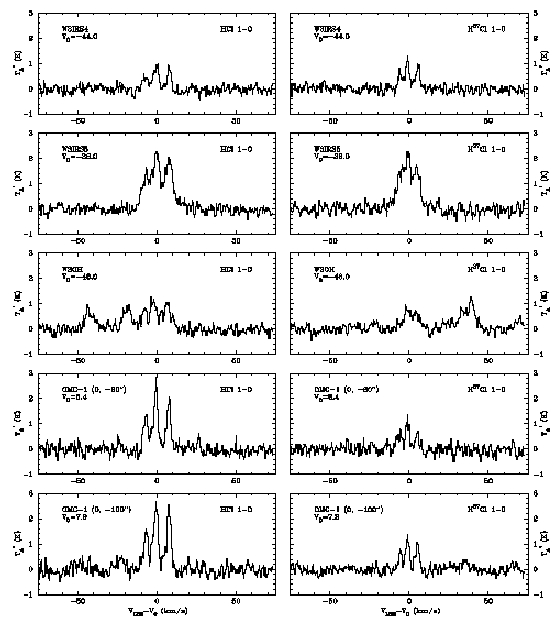
 A
Comprehensive Survey of Hydrogen Chloride in the Galaxy.
A
Comprehensive Survey of Hydrogen Chloride in the Galaxy. 
Hydride molecules in
interstellar medium are believed to be significant reservoirs
of heavy elements, which are of great importance as they are processed
into the
building blocks of planets, and eventually living material.
Hydrides are also
of great interests in astrochemistry as they are considered the root of
reaction
chains leading to the formation of gas phase molecules.
Unfortunately, very
little is known of these molecules from ground-based observations, due
to the
large opacity of Earth's atmosphere in far infrared and sub-millimeter
wavelengths.
As one of the heavier hydrides, hydrogen chloride (HCl) is
observable on the
ground only from a premium site such as Mauna Kea. The ground
rotational transition
(at 625.92 GHz) of HCl falls on the shoulder of a significant water
absorption line
of the atmosphere, therefore requiring exceptional atmospheric
conditions for the
observation. In addition, the hyperfine splitting of HCl rotational
spectrum
provides a straight-forward means to derive useful parameters such as
the excitation
temperature and optical depths of the HCl molecules. Moreover,
chemistry of chlorine
and hydrogen chloride in the interstellar medium is relatively simple
and well understood
in dense molecular clouds: HCl is expected to take up about one third
of the chlorine
in gas phase (Schilke, Phillips, & Wang 1995; Neufeld & Wolfire
2009). Therefore
measurements of HCl abundance would lead to reliable estimates of
chlorine depletion
relative to its abundance in the solar neighborhood.
The H37Cl isotope also has a similarly accessible
ground rotational transition
at 624.98 GHz. Observations of this transition would enable
measurements of the
35Cl/37Cl isotopic ratios in different parts of
the Galaxy. This ratio may
reveal the evolutionary history of the molecular material as heavy
elements are
synthesized in massive stars and mixed into surrounding molecular
environments
through supernova explosions.
HCl was first detected toward IRc2 in Orion A in emission by
Blake, Keene, & Phillips
(1985), and in absorption against dust continuum in Sgr B2, by
Zmuidzinas et al.(1995),
both aboard the NASA Kuiper Airborne Observatory with a beam width of
2.3'.
Ground-based observations at a higher spatial resolution of 12" were
carried out using
the 10.4-m telescope of the Caltech Submillimeter Observatory (CSO) by
Schilke,
Phillips, & Wang(1995) and Salez, Frerking, & Langer(1996)
toward OMC-1 and MonR2.
Salez, Frerking, & Langer(1996) also detected the H37Cl
toward OMC-1. Aside from
these early observations, relatively little is known about HCl in
different categories of
objects, such as evolved stars, active star forming regions, molecular
clouds with no
apparent star formation activity, etc.
Researchers led by Dr. Peng at the CSO took advantage of several
periods of
superb weather on Mauna Kea to conduct a comprehensive survey of HCl in
a sample of 27 well known objects in the Galaxy. Fourteen sources
in the
sample are also observed in the corresponding H37Cl
transition. They have
obtained clear detections in all but four of the targets, often in
emission. Absorptions
against bright background continuum sources are also seen in nine
cases, usually
involving a delicate balance between emission and absorption
features. Figure 1
show the H35Cl and H37Cl spectra for some of the
sources in the sample. HCl is
found in a wide range of environments, with gas densities ranging from
105 to 107 cm-3. The HCl abundance
relative to H2 is in the range of (3-30) x 10 -10.
Comparing with the chlorine abundance in the solar neighborhood, this
corresponds
to a chlorine depletion factor of up to about 400. The [35Cl]/[37Cl]
isotopic ratio is
rather varied, from unity to ~5, mostly lower than the terrestrial
value of 3.1. Such
variation is highly localized, and could be generated by the
nucleosynthesis in
supernovae, which predicts a 37Cl deficiency in most
models. The lower ratios
seen in W3IRS4 and W3IRS5 likely confine the progenitors of the
supernovae to
stars with relatively large mass (> 25 solar masses) and high
metallicity
(Z~0.02). The first part of the results concerning sources with
HCl emission has
been published
in the Astrophysical Journal (723 (2010), 218).
References
Blake, G. A., Anicich, V. G., & Huntress, W. T. 1986, ApJ, 300, 415
Blake, G. A., Keene, J., & Phillips, T. G. 1985, ApJ, 295, 501
Neufeld, D. A., & Wolfire, M. G. 2009, ApJ, 706, 1594
Salez, S., Frerking, M. A., & Langer, W. D. 1996, ApJ, 467, 708
Schilke, P., Phillips, T. G., & Wang, N. 1995, ApJ, 441, 334
Zmuidzinas, J., Blake, G. A., Carlstrom, J., Keene, J., & Miller,
D. 1995, ApJ, 447, L125

Figure 1.
H35Cl and H37Cl
J=1-0 emssion spectra toward W3IRS4, W3IRS5, W3(OH), and
two positions in OMC-1 offset from IRc2 in declination by -60" and
-100", respectively.
Velocity scale, VLSR - V0, refers to the main
hyperfine component.
Go back to A Digest of Recent News and
Scientific Results at the Caltech Submillimeter Observatory

 A
Comprehensive Survey of Hydrogen Chloride in the Galaxy.
A
Comprehensive Survey of Hydrogen Chloride in the Galaxy. 

 A
Comprehensive Survey of Hydrogen Chloride in the Galaxy.
A
Comprehensive Survey of Hydrogen Chloride in the Galaxy. 
